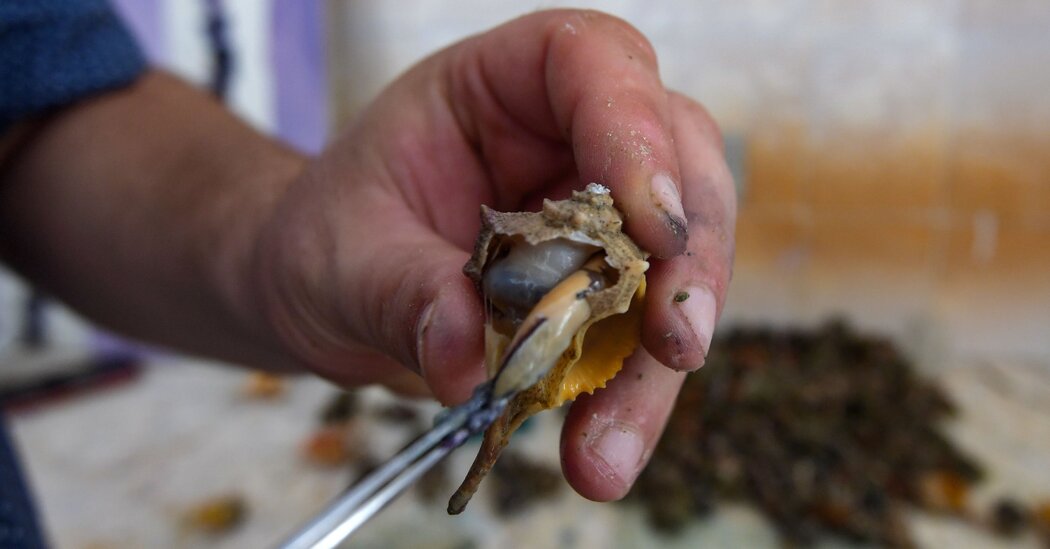The most prized pigment of antiquity was processed not from a tangle of root or the frothy extract of a weed, but by drawing out a slimy secretion from the mucus glands behind the anus of murex sea snails — “the bottom of the bottom-feeders,” the historian Kelly Grovier has written. The common name of the dyestuff, Tyrian purple, derives from the habitat of the mollusks, which the Phoenicians purportedly began harvesting in the 16th century B.C. in the city-state of Tyre in present-day Lebanon.
Because each snail yielded little more than a drop of the discharge — a clear, malodorous liquid — some 250,000 were required to produce an ounce of dye, by some accounts. Purple was labor-intensive, but so widely produced that piles of shells discarded millenniums ago are now geographical features in the region. The dye was also so pricey — worth more than three times its weight in gold, according to a Roman edict issued in 301 A.D. — that its use was reserved for priests, nobility and royalty. “Though purple may have symbolized a higher order, it reeked of a lower ordure,” Dr. Grovier writes in his book, “The Art of Colour.”
Where all this purple came from has long been a mystery. Just a few locations along the Levant’s southern coast and in Cyprus show evidence of dye-making at the start of the period, and all were on a modest scale. But a new study by researchers at the University of Haifa in Israel suggests that through most of the Iron Age biblical era, from roughly 1150 B.C. to 600 B.C., a small promontory called Tel Shiqmona on Israel’s Carmel coast was not a residential settlement, as previously supposed, but a major purple-dying factory.
“Tel Shiqmona fills in this gap with continuous production, most of the time in massive quantities,” said Golan Shalvi, a postdoctoral student in archaeology at the University of Chicago and the lead author of the paper. “For the majority of the Iron Age, it is the only site where manufacturing can be demonstrated with certainty.”
Aaron Schmitt, an expert on Phoenician culture who teaches archaeology at the Heidelberg University in Germany and who was not involved with the project, hailed the study for shedding new light on the neglected ruins. “To find a site that really specialized in this economic branch is highly significant and special,” he said.
The research, published in the Journal of the Institute of Archaeology of Tel Aviv, proposes that during the first half of the ninth century B.C., the Israelites took over Tel Shiqmona and set about cornering the lucrative purple-dye market by converting the small dye installation into a fortified manufacturing plant surrounded by a casemate wall. (This was at about the same time that Ahab ruled the Kingdom of Israel.)
The new operation was more or less a joint venture, run by the Israelites and staffed by skilled Phoenician workers who held the secrets to making the dye, Dr. Shalvi said. Whether the locals had continued the operation by coercion or cooperation is unclear.
In theory, the goods assembled at Tel Shiqmona, mainly purple-dyed wool or textiles, were distributed to the elite and temples across the area, including Israel, Phoenicia, Philistia, Aram, Judea and Cyprus. Dr. Shalvi said the dye probably created both the argaman (purple) and techelet (azure) mentioned dozens of times in the Hebrew Bible. Techelet was used for dyeing tzitzit (tassels) on tallits (prayer shawls) used in Jewish religious rituals, and inspired the blue of the Israeli flag.
“The purple manufacture at Tel Shiqmona overlapped with the existence of the First Temple in Jerusalem,” Dr. Shalvi said, referring to the house of worship that, according to Jewish tradition, was built by King Solomon on the spot where God created Adam. “For most of that time, it was the only place known to make the dye. Therefore, it is the only candidate to provide the color for the scarlet and sapphire hues of the temple’s robes and tabernacle curtains.”
It took guts
Tyrian purple was the sole colorfast dye known to the ancients; fabric tinted in the color grew brighter with weathering and sunlight. Shades ranged from bluish-green to a purplish red, depending on how the dye was prepared and fixed in textiles. The most vibrant tone was the deep crimson of “clotted blood” tinged with black, the Roman historian Pliny reported.
In imperial Rome, sumptuary laws restricted the buying and wearing of purple-dyed fabrics to the emperor (purple silk was to be used only at his direction under penalty of death) and, to a lesser extent, senators and consuls, who were allowed to wear broad bands of purple at the edges of their togas.
The name and provenance of Tyrian purple were inventions of the Romans. As far back as 1900 B.C., the Minoans of Crete were already preparing a purple dye from marine snails, spawning an industry that then caught on and flourished throughout the eastern Mediterranean. The center of production is thought to have moved to the port of Tyre, although Dr. Schmitt said it could not be corroborated by primary sources, either textual or archaeological. At the port, the snails were gathered from shallow waters and left to rot in large vats before being distilled into the purified dye. (Phoinike, the area’s corresponding Greek name, is related to phoinix, meaning “reddish purple,” leading some scholars to speculate that Phoenicia was “the land of purple.”)
Julius Pollux, a Greek scholar and grammarian from the second century A.D., attributed the discovery of the color to Tyrian Hercules, known to the Phoenicians as Melqart, guardian deity of Tyre. In his “Onomasticon,” a 10-volume thesaurus, Pollux relates that a nymph named Tyrus was walking along the beach when her dog bit into a sea snail, staining the dog’s mouth an intense purple. Tyrus was enthralled by the brilliance and told Hercules, her lover, that she wanted a robe of the same color. Hercules complied and purple became a royal rage.
In the 17th century, the artist Peter Paul Rubens recreated the yarn in the oil painting “Hercules’ Dog Discovers Purple Dye.” Alas, he got the shell wrong, depicting a spiral nautilus snail instead of a prickly murex.
Shell game
Tyre is 30 miles north of Tel Shiqmona, where the purple pigment was created from the dried and boiled guts of three species of predatory sea snails: the spiny dye-murex (Bolinus brandaris), the banded dye-murex (Hexaplex trunculus) and the red-mouthed rock shell (Stramonita haemostoma). Each added a slightly different cast to the mix.
Tel Shiqmona had long confounded archaeologists, who wondered why what looked to be some kind of fort had been erected far from agricultural lands on a rocky stretch of shoreline that didn’t offer safe harbor to ships.
From 1963-77, the eight-acre site was excavated extensively by Yosef Elgavish, an Israeli archaeologist. Working on behalf of the Haifa Museum, he unearthed weaving and spinning equipment, large purple-stained ceramic vats and evidence of human habitation dating to around 1500 B.C. Although some archaeological layers harbored Phoenician pottery, Dr. Elgavish also found a four-room house and olive presses, which he identified as typical of the 10th-century B.C. settlements of the Israelites.
“Dr. Elgavish had a hunch that Tel Shiqmona had some role in the production of the purple dye, but he didn’t delve into the amount of production or who ran the dye process,” Dr. Shalvi said.
For the next four decades, the site was almost completely ignored for academic research. “The results and finds of the early expeditions were neither researched nor published,” Dr. Shalvi said. In 2016, he and Ayelet Gilboa, his doctoral adviser at the University of Haifa, began a project to save what they called the “cultural and intellectual assets” hidden in the forgotten finds.
Dr. Shalvi soon realized that defining Tel Shiqmona’s as exclusively Israelite did not reflect the region’s complexity. He divided the site’s Iron Age chronology into four main episodes: a Phoenician village (1100 B.C. to 900 B.C.); a walled enclosure controlled by the Israelites (900 B.C. to 740 B.C.); an ephemeral resettlement after the destruction of the kingdom and the facility (740 B.C. to 700 B.C.), and an unfortified industrial compound under Assyrian domination that survived until the Babylonian takeover of the territory (700 B.C. to 600 B.C.)
Three years ago, after carefully reviewing the thousands of finds from Dr. Elgavish’s excavation, Dr. Shalvi had an epiphany. ”I discovered purple traces that no one else had observed,” he said. “As soon as my eyes were opened to the purple staining pattern, I noticed it everywhere.”
That afternoon he called Dr. Gilboa and told her about his revelation. “We discussed whether it might be a good idea for me to see a psychiatrist,” Dr. Shalvi said with a dry chuckle. “Fortunately, chemical analysis demonstrated that in every case the purple was real.”



